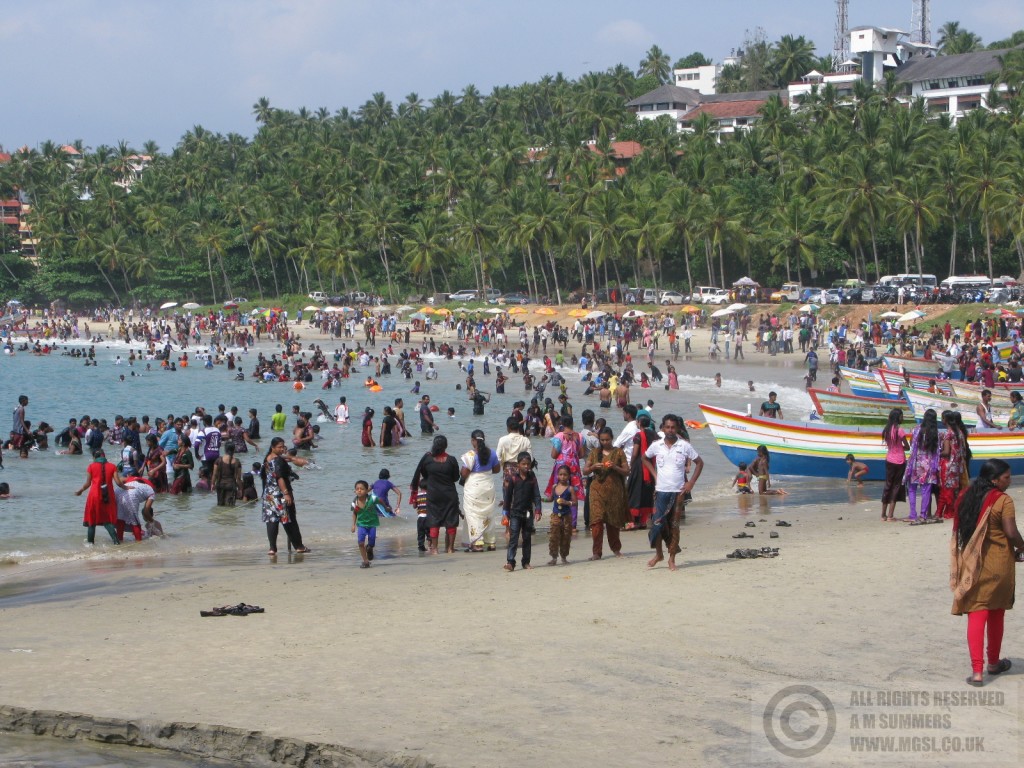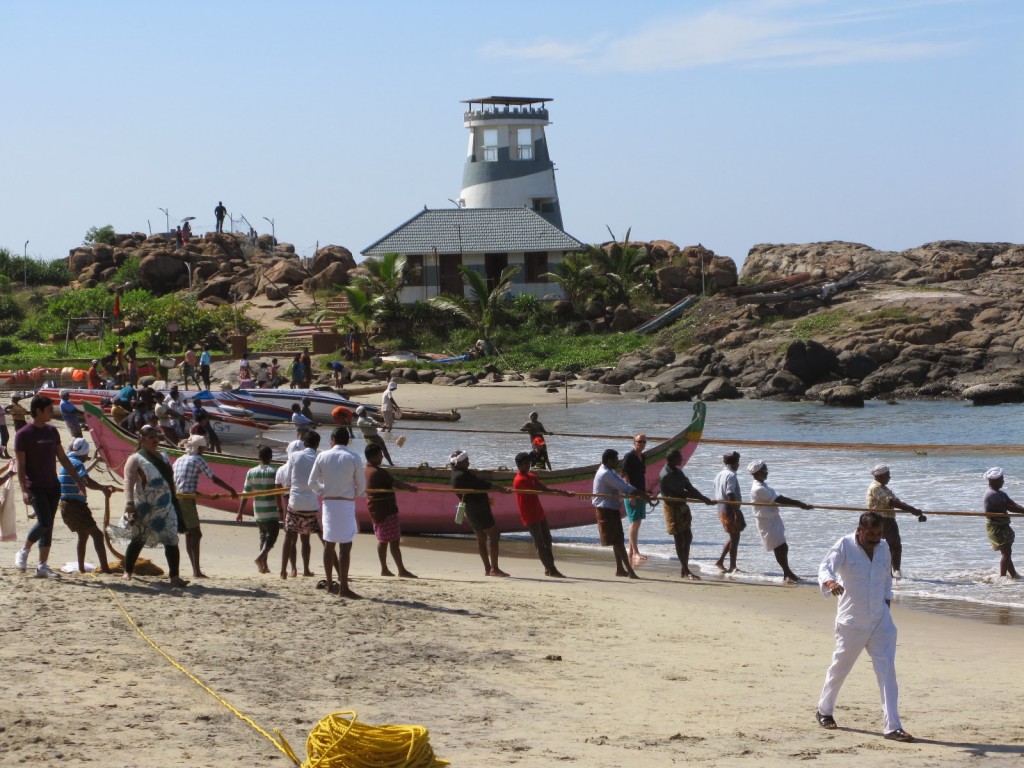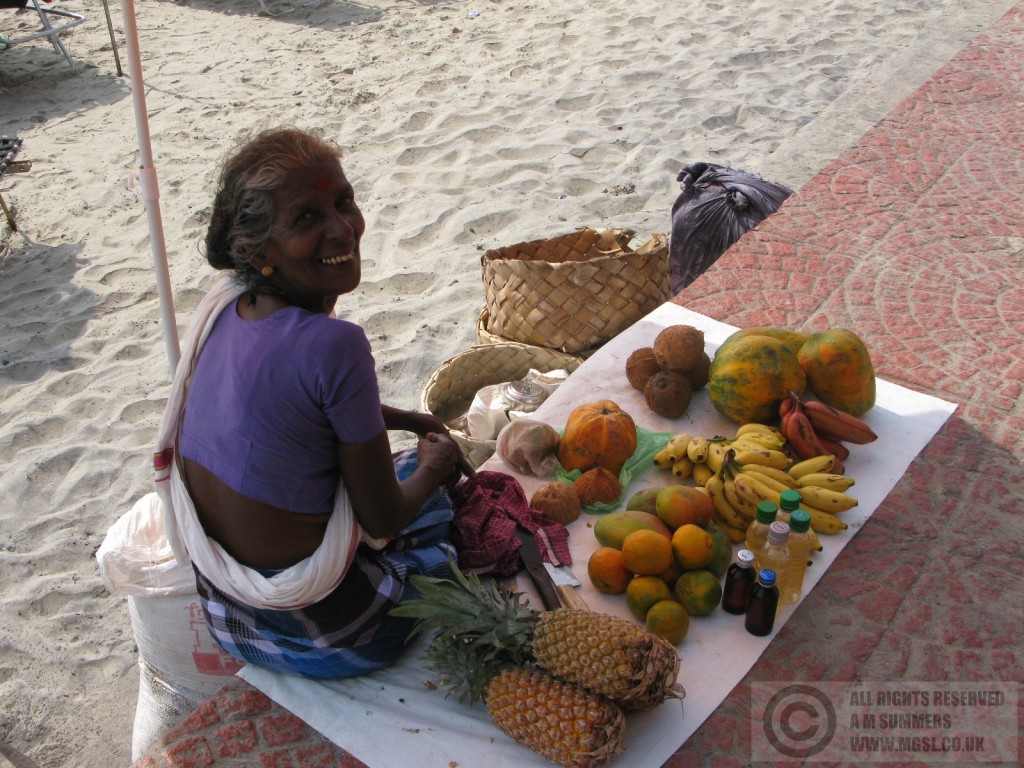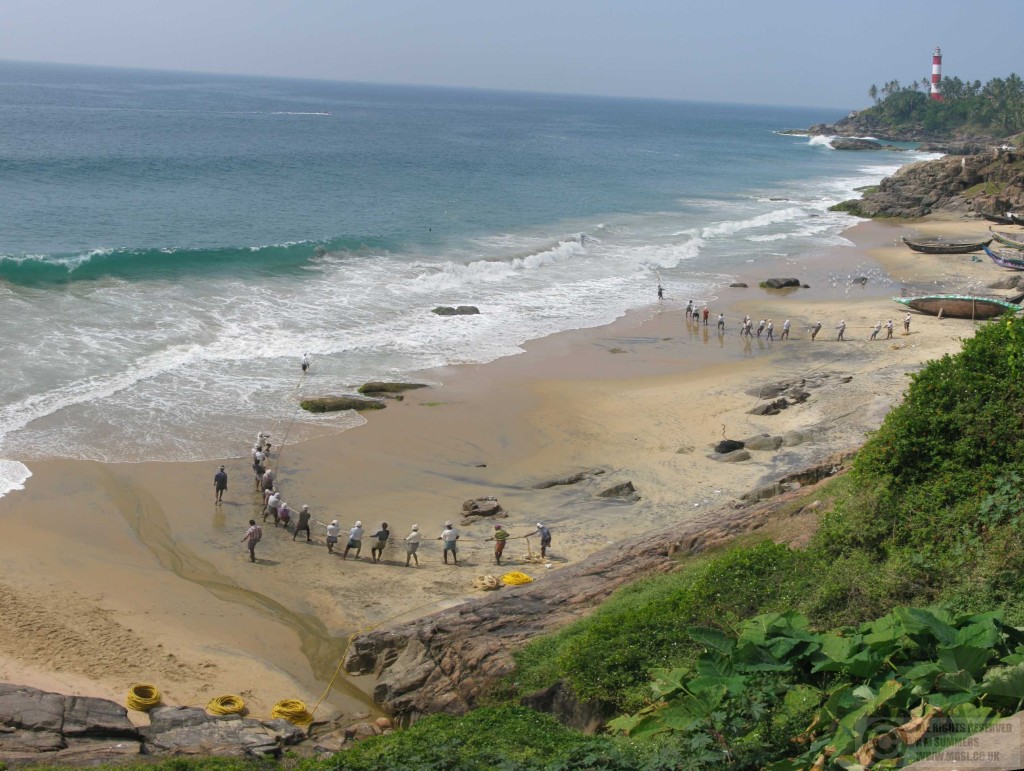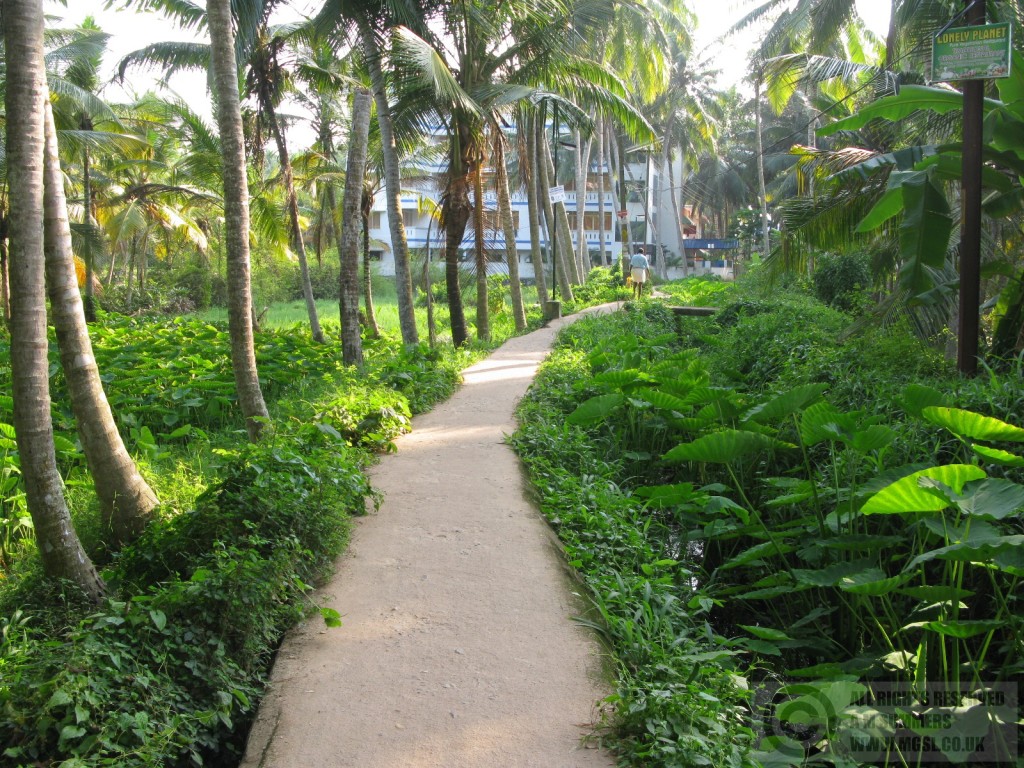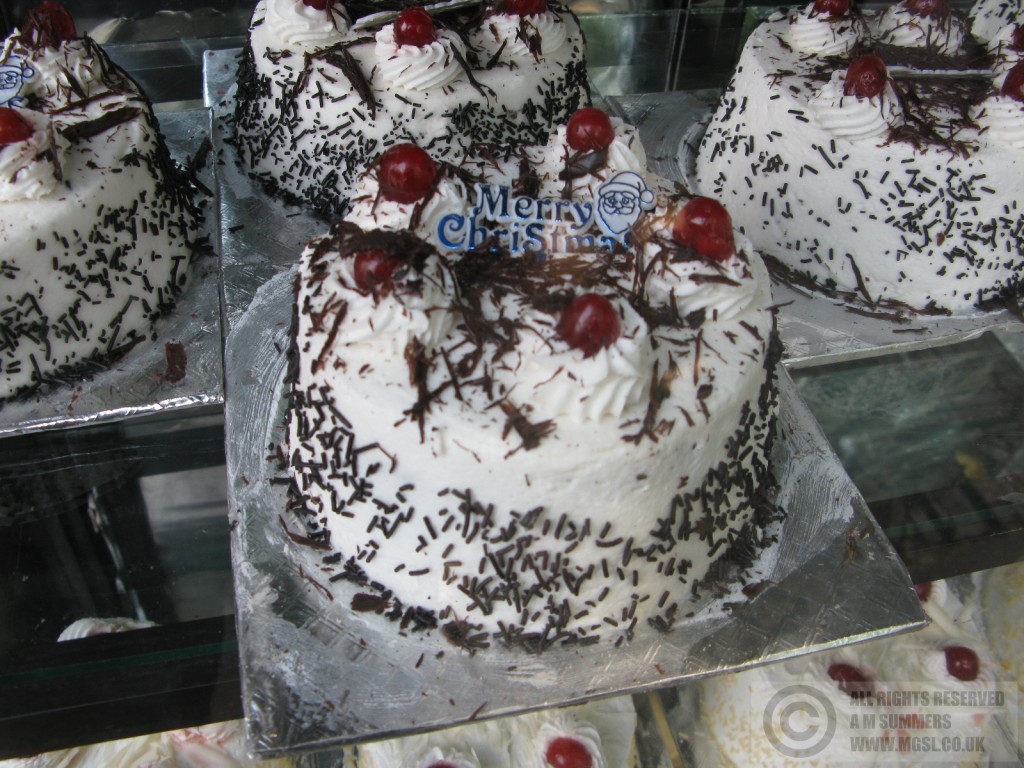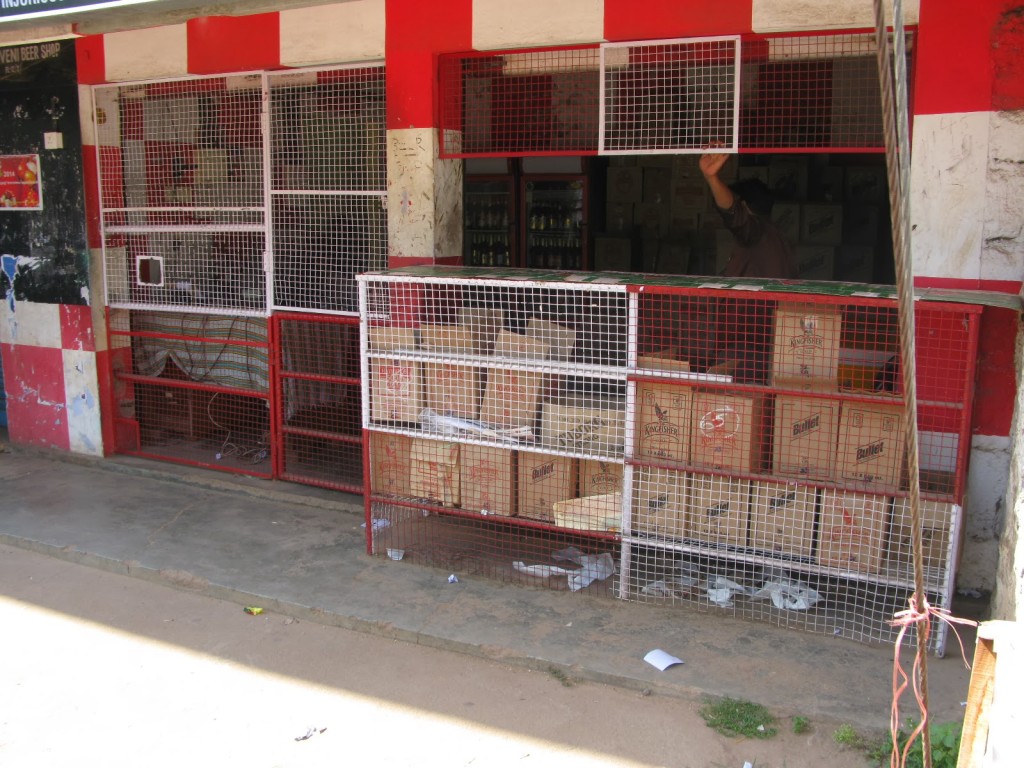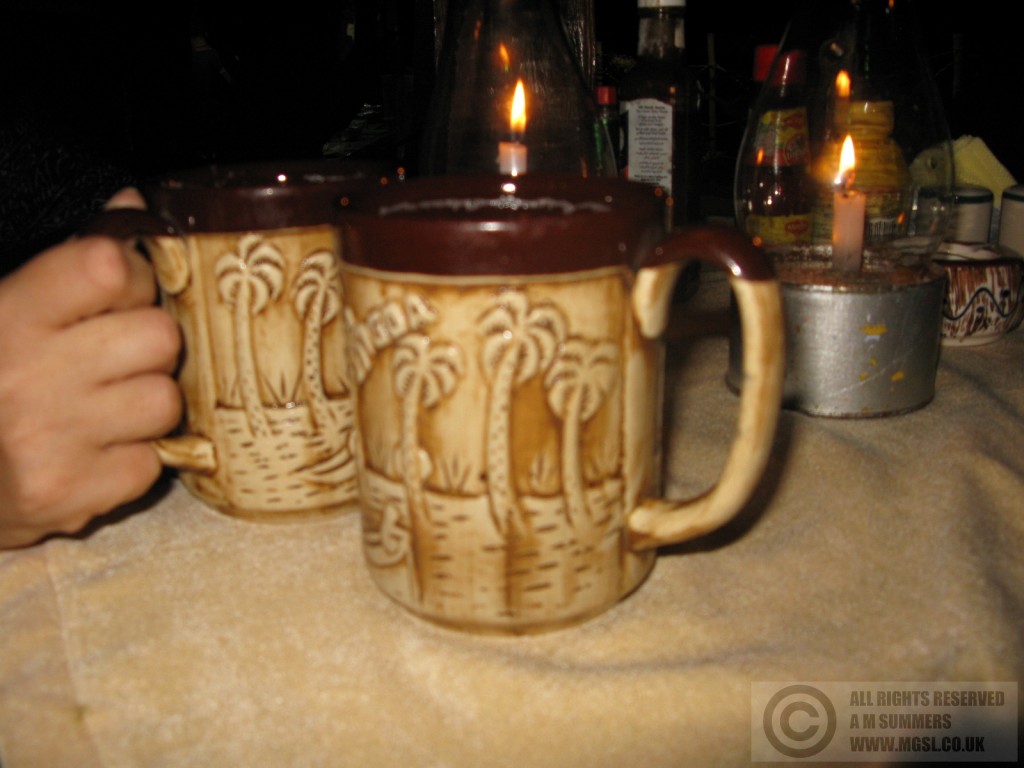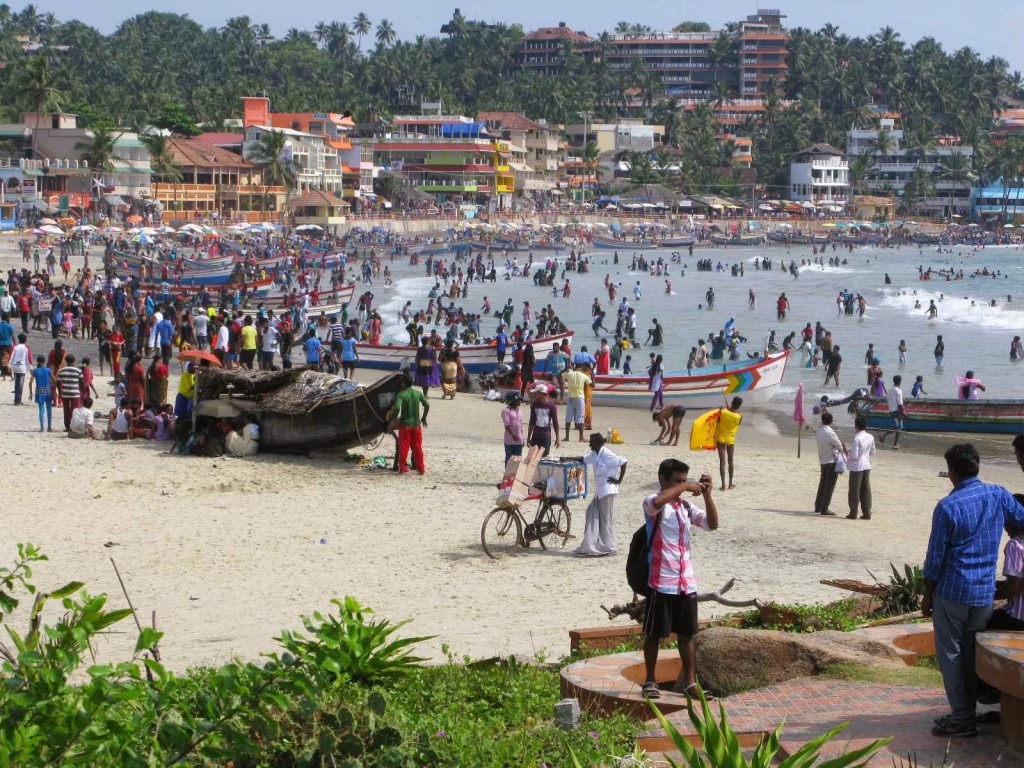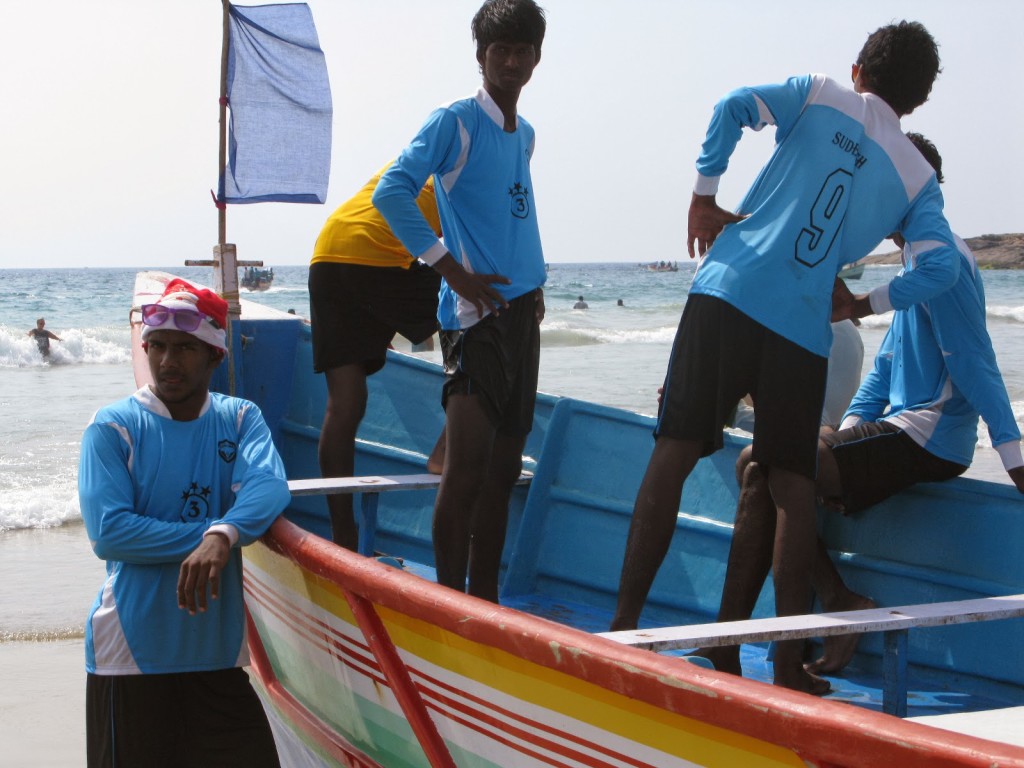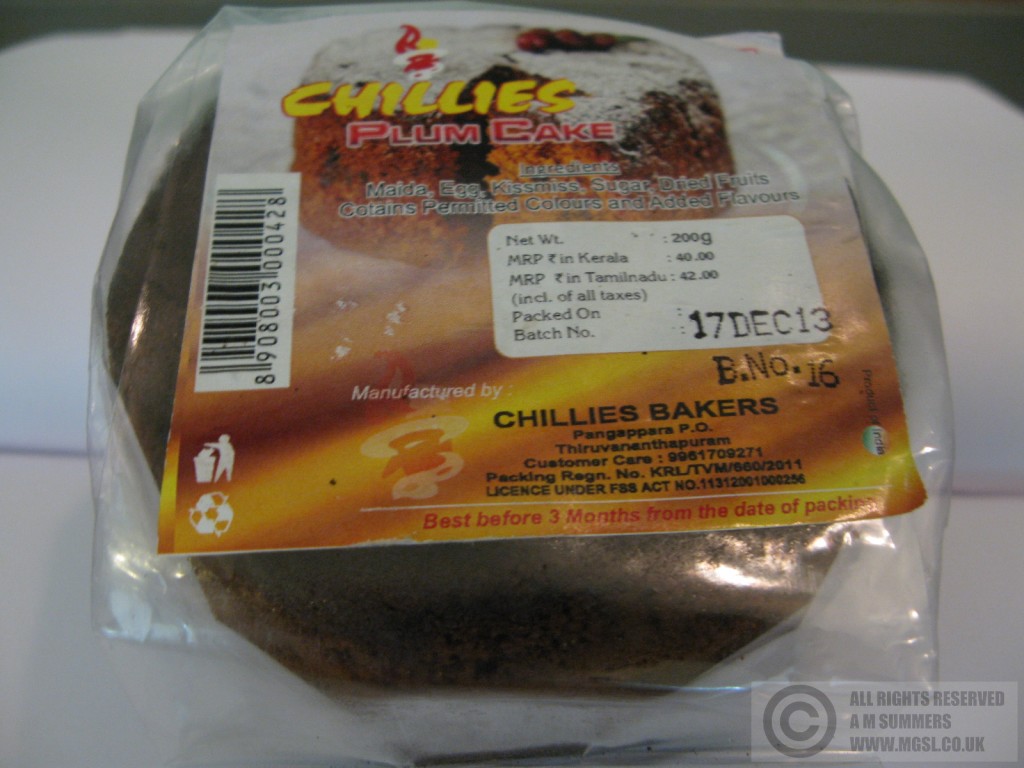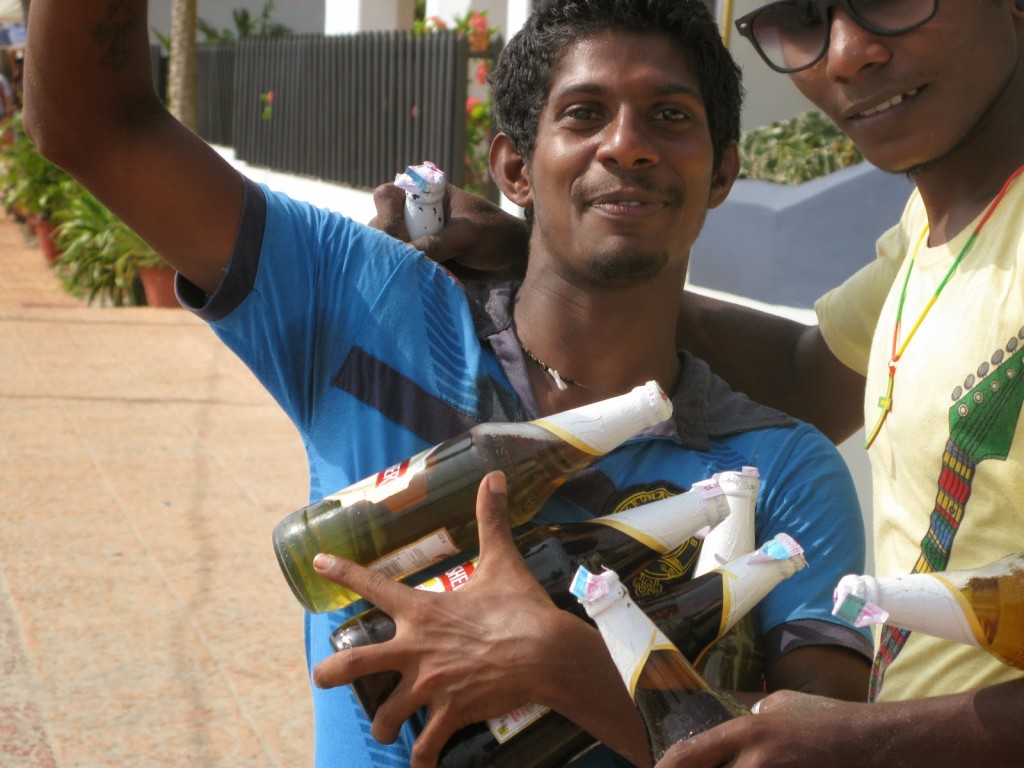Christmas in Kovalam:
Wednesday 25th December 2013
It’s been an unusual Christmas Day, so far. I wouldn’t normally get up at 06:30, much less go for a 2 hour walk – after lunch perhaps, but not before breakfast. Even at 06:45 there were plenty of people on Kovalam’s beaches, although the vast majority were Indian. Even on holiday, Indians sensibly rise early to take advantage of the cool window before the sun gets fierce, and so they were strolling along Lighthouse beach and dabbling in the shallows.
Around the corner on Hawah beach, the fisherman were hauling in their nets, as usual (they had probably been there for hours already), while local lads played an energetic game of soccer. This is a working beach, the beach that local people use, much more so than Lighthouse where Europeans lounge on sunbeds being pestered by women selling fruit and men selling sarongs or cigarettes (always that strict gender demarcation). Skimpy bikinis sometimes draw even less welcome attention in the form of stares and photos from men unused to seeing women so scantily clad – Indian women usually bathe fully clothed, shorts and T-shirts for the modern girl, sari or salwar kameez for the traditionally-minded.
On Hawah the sales are of fish – men cluster around the catch, jostling to bid, or to collect their share if they were part of the tug-of-war team that pulled it in. It takes about 30 men, working in two teams, to bring in a beach net and sometimes there is little reward for an hour or more of hard chanting and pulling. This morning though a good shoal of mackerel-like fish had been landed. A few women with small plastic bags waited outside the main throng, hoping to pick up cheap leftovers for their families once the guys with plastic crates had taken their fill and left for wherever they planned to sell it on. Fishing is big business in Kovalam – at night the lights of the boats on the horizon make it looks as though there is a peninsula stretching across the bay, so many are there.
Past the headland that is home to the Leela Hotel, its concrete boxes cascading down the hill (ugly, but affording each room a balcony with a sea view), Kovalam Beach is home to more fishermen, a Hindu temple, a mosque, and a scruffy car park where groups of just-arrived day trippers were picnicking alongside their coaches, tarpaulins spread on the litter-strewn gravel – obviously they didn’t want to risk getting sand in their puttu by sitting on the beach.
Beyond another headland is Samudra beach, with a crop of newish hotels and a recently renovated park, then the lagoon that fronts the Taj Vivanta, Kovalam’s most luxurious resort (a snip at £360 per night for their cheapest room). We walked as far as Bait, their highly-rated (on Tripadvisor) seafront restaurant, a surprisingly scruffy looking edifice (if they were hoping for ‘rustic’ they missed by a wide margin) – it was closed and no menus had been left out, so we couldn’t see whether it was worth a trip back. By now the sun was peeking over the hill, so it was time to return and treat ourselves to a breakfast of coffee and cake at the German Bakery.
The big advantage of touristy locations is the food. Of course it’s laudible to immerse oneself completely in the cuisine of the country in which one is travelling, but after a few weeks even the best gastronomy palls. After all, I don’t dine exclusively on British fare at home – even though I like Indian food very much, I do want a change now and then. And although they grow coffee in the highlands of southern India, it unfortunately doesn’t often manifest itself as a good cup of the beverage – the ubiquitous Nescoffee holds sway in all but a few foriegn-owned establishments, swanky hotels and, in the more cosmopolitan places, branches of Cafe Coffee Day (India’s answer to Starbucks).
Even here in Kovalam, the repertoire of foreign food is limited to standard bill of fare that is repeated at almost all the beachfront restaurants. There is usually a decent list of curries, veg and non-veg – they are, however, mostly things that would be familiar from an Indian restaurant menu in the UK, and sometimes even that famously British invention, chicken tikka masala, can be found. These are supplemented by some Chinese fried rice and noodle dishes, pasta and pizza, very occasionally a bit of Thai or Mexican, and then some mysterious ersatz continental ‘sizzlers’, the main point of which, as far as I can tell, is to fill the restaurant with steam. The pizzas are generally not bad at all. Indian restaurants have an advantage over those in most countries which attempt to recreate the output of a wood-fired Italian pizza oven – they have tandoors, and they are used to making naan bread. Lower the topped dough into the fiery interior of a tandoor on a tin plate held with a pair of pliers and hey presto, in less than 5 minutes you have a crisp and bubbling pizza that would not disgrace a Neapolitan. They make mozzarella here (why not, they have plenty of buffalo) and are even starting to produce olive oil – middle class Indians are increasingly demanding a healthier alternative to the traditional ghee but imported oil is very expensive, so olive groves have been planted in Gujarat.
There is also a small wine industry here, but it faces some serious hurdles because alcohol is not generally approved of. Muslims of course refuse it on religious grounds, as do devout Hindus and Sikhs. You can be sure that any restaurant that proclaims itself as ‘pure veg’ will not serve beer. Unfortunately most of the Indian men at the bottom end of the social scale (ie the vast majority) who do drink, do so with the express intention of getting as drunk as possible as quickly as possible. This has led to a market which is tightly controlled by the government in most states, in an attempt to make such drunkeness more difficult. Goa is famously lax, but buying spirits in Kerala involves a trip to one of the relatively few government-owned liquor stores, where bottles of Indian-made imitations of global brands are dispensed through a small hole in a wire cage. Technically speaking, all Indian spirits are a type of rum, being based on sugar cane – but the added flavours and colours allow it to be labelled as whisky, brandy, gin etc. The quality is variable, but it’s half the price of the genuine article (which is occasionally available). I actually prefer Indian Honey Bee brandy to the French stuff – it has an interesting caramelised banoffee pie flavour.
Beer is similarly controlled – although there are more shops, you can only buy 6 bottles at a time, and it is supposed to be concealed while you are carrying it. A tuk tuk driver can be fined if found transporting a passenger with more than 6 bottles, and hotel owners fined if a guest has more than 6 bottles in their room. Inevitably, would-be drunkards circumvent the restrictions by frequenting illicit toddy shops where the adulterated hooch may just poison them outright. It’s difficult and extremely expensive for a restaurant to obtain a licence, so those in tourist resorts don’t bother – instead the beer is served in oversized mugs in case the police drop by, and the bill will list it as ‘pop’ or ‘special tea’. This ploy cannot possibly fool anyone (the restaurants even use identical mugs, and need to dispose of hundreds of empty bottles), and yet raids are infrequent – one can only conclude that baksheesh changes hands on a fairly large scale.
Indian wine is expensive – a halfway decent bottle such as Sula will cost £5-£7 in a beer shop, and upwards of £14 in a Kovalam restaurant (much more than in Goa) and even at those prices it won’t be memorable (the Rs20 glass of Golconda Red that I bought in the hotel in Udupi was memorable but for the wrong reason – it went straight down the sink). We did find very reasonably priced port in one Goan beach restaurant – sweet and fruity, it made a pleasant Ribena substitute but it didn’t remotely resemble the real thing.
The vast majority of women don’t drink at all, and large groups of them occasionally protest vociferously in an attempt to close a liquor store that is facilitating their husbands’ drunkenness (thereby depleting the family finances). Most bars are exclusively male preserves, dark and secretive – the entrance of a woman, especially a white one, will usually result in a deafening silence and open-mouthed stares. Middle class businessmen, the only numerically significant social drinkers, are unlikely to be tempted away from their favoured whisky and water. Given all these obstacles, a culture of relaxed social wine drinking is unlikely to flourish anytime soon.
As we ate our breakfast it became clear that Christmas Day is a public holiday in Kerala. Small open fishing boats, some decked with bunting or balloons, were disgorging passengers onto the beach – family groups and gaggles of young men, the latter often dressed in identical football strips, sometimes accessorised with santa hats. From the way that some of them started to dance the moment their feet hit the sand (and occasionally while they were still at sea) it was clear that the drinking had started early for some.
By the time we ventured back to the beach in the early afternoon, after a Christmas lunch of masala dosa, it was packed with day trippers, children (and some adults) running in and out of the water and pelting each other with handfuls of wet sand. Boats were still coming and going, taking shrieking and waving passengers for joy rides around the bay – no segregation, so the bathers thronging the shallows were in real danger of being mown down as the boats tried to find a space to drive onto the shore. Two or three lifeguards were vainly trying to keep order, blowing their whistles and waving frantically at those swimming too far out (Kovalam has notoriously lethal rip currents) – nobody took a blind bit of notice, and if the lifeguards had hoped for help from the police they would have been disappointed as the sole occupant of the police post was having a nice little snooze.
With the luxury of a fridge in our room, our own Christmas preparations had included a bus trip to the Trivandrum liquor store and a trek to the Kovalam beer shop, the latter being inconveniently located up a steep hill (and, probably not by coincidence, very close to the police station). With beer, whisky and rum, plus a carton of fruit juice, we had all we needed for an afternoon of poolside relaxation in the comfort of our own terrace, so we retreated to the peace and quiet of the Thushara. Indian crowds that include families are generally not intimidating, even when alcohol is involved, but the noise level gets wearing after a while.
The crowds had thinned substantially by dinner time – the stragglers strolled along the promenade but, unlike the tourists, received little attention from the staff of the beach restaurants whose job it is to tempt customers through the door (aided by displays of seafood that this evening were even more opulent than usual, piled high with prawns the size of a baby’s arm). Most of the day trippers would consider the prices prohibitive, and if they planned to dine in Kovalam at all it would be in one of the cheaper places in the maze of paths behind the beach. Plenty of Indians do frequent the beach front establishments, but they are overnighting middle class holidaymakers, not day trippers. The restaurant staff have no difficulty in distinguishing between them. Clothing and, very often, skin colour mark them out – those with the darkest skin are most likely to be at the bottom of the social hierarchy. Dark mahogany = fisherman or labourer, palest caramel = high caste professional – or at least, that’s what people seem to think. Consequently you would never catch an Indian sunbathing – young women wield umbrellas against the tanning effects of the sun, and adverts for face cream promise not youth, as in the UK, but fairness (and not just creams aimed at women). To judge from TV adverts, you would think that India is populated entirely by people whose complexions are lighter than that of the average Italian.
We dined on fish platters that turned out to be far larger than we could eat. For some reason the cook had thought it a good idea to douse the prawns in barbecue sauce – it’s not a culinary innovation that I recommend. Just as we were finishing a dog wandered through the restaurant. Nothing odd there, Indian beaches come with as many dogs as the restaurant leftovers will support – this dog, however, was wearing illuminated red devil horns. At least I think it was – perhaps I’d just had more rum than I realised!


